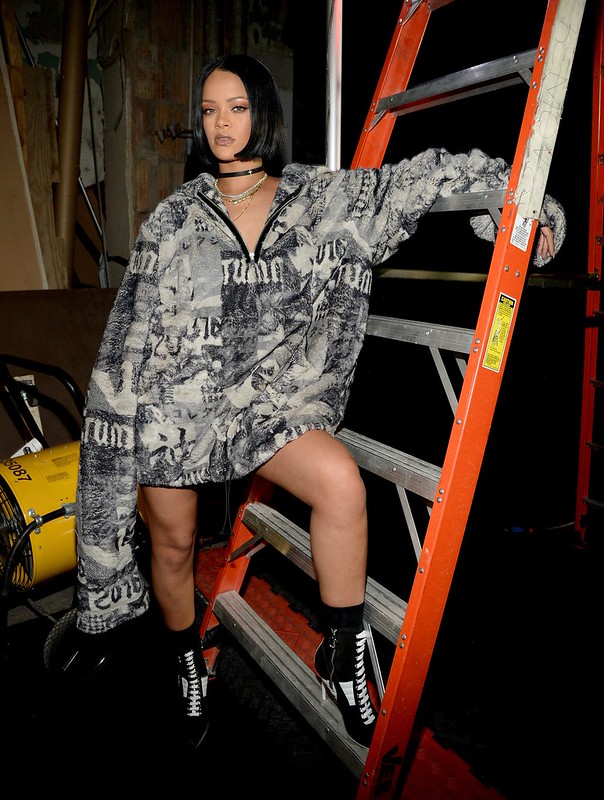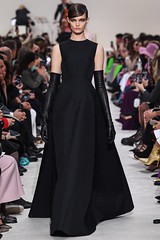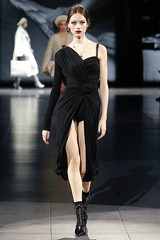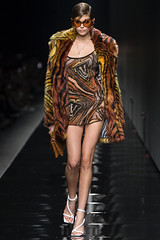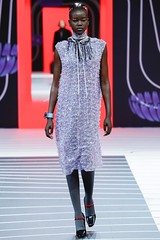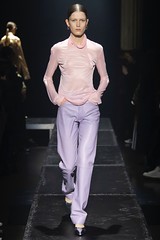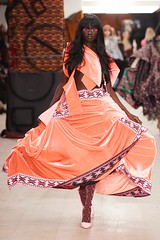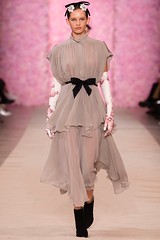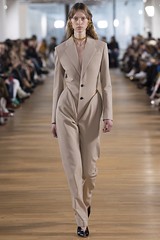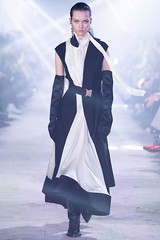The Lars Andersson collection for Fall/Winter 2012, presented at the Soho Grand, was like its fabrics: soft, dark, touchable. It was his first presentation. Rich, deeply-colored knits cloaked the models—who wore eye makeup so dark and had lips so stained that they looked haunted, ghostly—protectively; some were belted, though most of them loosely draped the body. Plums, navies, blacks; ankle-length coats; ribbed, marbled, and quilted patterns mixed with solids; warmly layered scarves: the pieces had a fairytale quality to them, evoking a grown-up Red Riding Hood or a mythical journey. Suitably, the pieces had been on a mythical journey themselves, entirely hand-crafted and knit by Andersson and his team of knitters.
Curious about the surprisingly otherworldly vibe of such a simple collection, we spoke to the Sweden-born, New York-based Andersson for a few moments about the pieces and his overall inspiration.
MONICA USZEROWICZ - I was interested in the idea of landscape as an influence for you. I read in a few interviews that you’ve been inspired by New York City, your memories of Sweden…
LARS ANDERSSON - Yeah, the dark forests. The dark forest is magical. And last year, I went to the Redwoods.
MU - Also magical in a different way.
LA - Super magical. I mean, very different, but it was amazing.
MU - Did that provide any influence?
LA - Yeah, we went on a road trip. Me and my friend met up in L.A.; we drove to San Diego to see a concert—she was styling Billy Idol—and then we drove up to Portland, Oregon. We drove through Big Sur. It was amazing. And then we went up to the Harbin Hot Springs, which is the most crazy, amazing place ever. In the Redwoods, up in the north, we found this museum of Native American artifacts, and I bought these two books by Edward S. Curtis. They were photography books [photos of Native Americans], I think from the late 1800s, early 1900s. I looked through them and, naturally, I’m inclined to love those kinds of things—all the drapes. It was just a big piece of fabric, put together with a pin. Without even really thinking about it, that sort of became a big inspiration for this collection. Plus, I have my things that I always do that are partly for sales. This is my first presentation, so normally I don’t think presentation-wise. Normally I think about what’s working for sales. But I tried to incorporate bigger pieces that I really want to have.
MU - Do you find that you’re more influenced by things in nature, history, images, than by trends in fashion?
LA - Oh yeah, totally.
MU - I feel like there is a beautiful story to your pieces.
LA - I’m interested in the magicalness of things. Magical forests, magical tribes. There’s so much magic in the world. This sounds all hippy-dippy, but there’s a lot of amazing things. And I happen to like that. The person standing next to me might not. But I’m really into it. Of course, you can’t ignore fashion. We’re living in New York City. It’s one of the fashion capitals. But here needs to be a balance. I feel like I do a very urban collection, though I think it’s very magical or mystical or whatever the word could be.
MU - I think another way you strike that balance between fashion and your other influences is your focus on real craftsmanship.
LA - Totally. The craft that we’re doing—it’s me and my knitters. We knit all the fabric on handlooms, we hand-crochet every single seam together. This is a piece of artwork. This is an artisan work. I think—for sales, for example—people wonder, “Why is this minimal sweater seven hundred dollars in the store?” But when you know the story of it, you get it. And also, I use the best yarn—
MU - What yarn and materials do you like to use?
LA - I use silk, wools, cottons, linens, cashmere. I don’t use any unnatural fibers. Sometimes there is a little bit of a rayon mix or some lycra, but that’s it. I feel the craft of the work is important.
MU - I hope you’ll always be able to maintain some element of your hand in the pieces.
LA - I still have to knit very little, so little it’s barely there. But I do like to knit the samples. I feel like you can get a product made in China that looks really nice. The product is going to be a quarter or a tenth of the price of mine. But, you know, I hope people value the fact that someone is actually sitting down, taking their time, and doing this craft. People in China, or in a factory, are also doing this by hand, but it is a factory-produced product. It is a different thing. They’re working with a different mentality.
